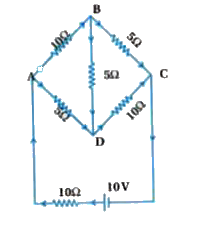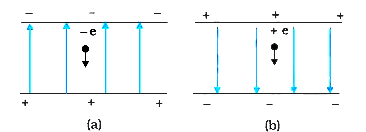An electron falls through a distance of 1.5cm in a uniform electric field of magnitude 2×104NC−1. The direction of the field is reversed keeping its magnitude unchanged and a proton falls through the same distance. Compute the time of fall in each case.Solution in Gujrati
Step by step video & image solution for An electron falls through a distance of 1.5cm in a uniform electric field of magnitude 2 times 10^4 NC^-1. The direction of the field is reversed keeping its magnitude unchanged and a proton falls through the same distance. Compute the time of fall in each case. by Physics experts to help you in doubts & scoring excellent marks in Class 12 exams.
Updated on:21/07/2023Topper's Solved these Questions
- ELECTROMAGNETIC WAVESBOOK - KUMAR PRAKASHANCHAPTER - ELECTROMAGNETIC WAVESEXERCISE - BOARD.S QUESTION PAPER MARCH - 2020 (PART - B) SECTION - C
5 Videos
- ELECTROMAGNETIC WAVESBOOK - KUMAR PRAKASHANCHAPTER - ELECTROMAGNETIC WAVESEXERCISE - BOARD.S QUESTION PAPER MARCH - 2020 (PART - B) SECTION - A
10 Videos
- ELECTROMAGNETIC INDUCTIONBOOK - KUMAR PRAKASHANCHAPTER - ELECTROMAGNETIC INDUCTIONEXERCISE - Section D MCQs (MCQs asked in Competitive Exams )
38 Videos
- ELECTROSTATIC POTENTIAL AND CAPACITANCEBOOK - KUMAR PRAKASHANCHAPTER - ELECTROSTATIC POTENTIAL AND CAPACITANCEEXERCISE - Section D ( MCQs asked in Cometitive Exams )
39 Videos
Similar Questions
Determine the current in each branch of the given network.

View SolutionDerive expression for the capacitance of the parallel plate capacitor,
View SolutionThree pure inductance each of 3 H are connected as shown in figure. The equivalent inductance of this connection between points A and B is ......

View SolutionCapacitance of a capacitor 100 μ F. The work is done for depositing chargc 8×10−18 C on it will be .........
View SolutionAn electron (mass m_(e ) )falls through a distance d in a uniform electric field of magnitude E. , The direction of the field is reversed keeping its magnitudes unchanged, and a proton(mass m_(p) ) falls through the same distance. If the times taken by the electrons and the protons to fall the distance d is t_("electron") and t_("proton") respectively, then the ratio t_("electron")//t_("proton") .
View SolutionAn electron falls through a small distance in a uniform electric field of magnitude 2×104NC−1. The direction of the field reversed keeping the magnitude unchanged and a proton falls through the same distance. The time of fall will be
View SolutionAn electron falls through a distance of 1.5 cm in a uniform electric field of magnitude 2.4xx10^(4) NC^(-1) [Fig.1.12 (a)] . The direction of the field is reversed keeping its magnitude unchagned and a proton falls through the same distance [Fig. 1.12 (b) ]. Complute the time of fall in each case. Contrast the situation (a) with that of free fall under gravity.
View SolutionA proton falls dwon through a distance of 2 cm in a uniform electric field of magnitude 3.34xx10^(3) NC^(-1) . Determine (i) the acceleration of the electron (ii) the time taken by the proton to fall through the distance of 2 cm, and (iii) the direction of the electric field.
View SolutionAn electron falls through a distance of 1.5 cm in a uniform electric field of magnitude 2.0×104NC−1. The direction of the field is reversed keeping its magnitude unchanged and a proton falls through the same distance. Compute the time of fall in each case. Contrast the situation with that of 'free fall under gravity'.

View Solutionकोई इलेक्ट्रॉन विरामावस्था से किसी एकसमान तथा। ऊपर की ओर ऊध्याधर C विद्युत क्षेत्र E में दी गई दूरी। तक गिरता है। अब विद्युत क्षेत्र का परिमाण अपरिवा रखते हुए इसकी दिशा उत्क्रमित कर दी जाती है। किसी तक प्रोटॉन को विरामावस्था से उतनी ही ऊर्ध्वाधर दरी h तक. इसमें गिरने दिया जाता है। प्रोटॉन के गिरने में लिए गए समय की तुलना में इलेक्ट्रॉन द्वारा गिरने में लिया गया समय है-
View SolutionAn electron falls through distance of 1.5 cm in a uniforth electric field of magnitude 2.0xx 10 ^(4) NC^(-1) The direction of the field is reversed keeping its magnitude unchanged and a proton falls through the same distance compute the time of falls in each case . Contrast the situation with that of 'free fall under gravity'
View SolutionAn electron falls throgh a distance of 1.5 cm in a uniform electric field of magnitude 2.0 xx10^(4) N c^(-1) the direction of the field is reversed keeping its magnitude unchanged and a proton falls through the same distance compute the time of falls in each case contrast the situation with that of free fall under gravity
View SolutionAn electron falls throgh a distance of 1.5 cm in a uniform electric field of magnitude 2.0×104Nc−1 the direction of the field is reversed keeping its magnitude unchanged and a proton falls through the same distance compute the time of falls in each case contrast the situation with that of free fall under gravity

View SolutionAn electron falls through a distance of 1.5 cm in a uniform electric field of magnitude 2.4×104NC−1 [Fig.1.12 (a)]. The direction of the field is reversed keeping its magnitude unchagned and a proton falls through the same distance [Fig. 1.12 (b) ]. Complute the time of fall in each case. Contrast the situation (a) with that of free fall under gravity.

View SolutionAn electron falls through a distance of 1.5cm in a uniform electric field of magnitude 2×104NC−1. The direction of the field is reversed keeping its magnitude unchanged and a proton falls through the same distance. Compute the time of fall in each case.
View SolutionAn electron falls through a distance of 1.5cm in a uniform electric field of magnitude 2×104NC−1. The direction of the field is reversed keeping its magnitude unchanged and a proton falls through the same distance. Compute the time of fall in each case.
View Solution
